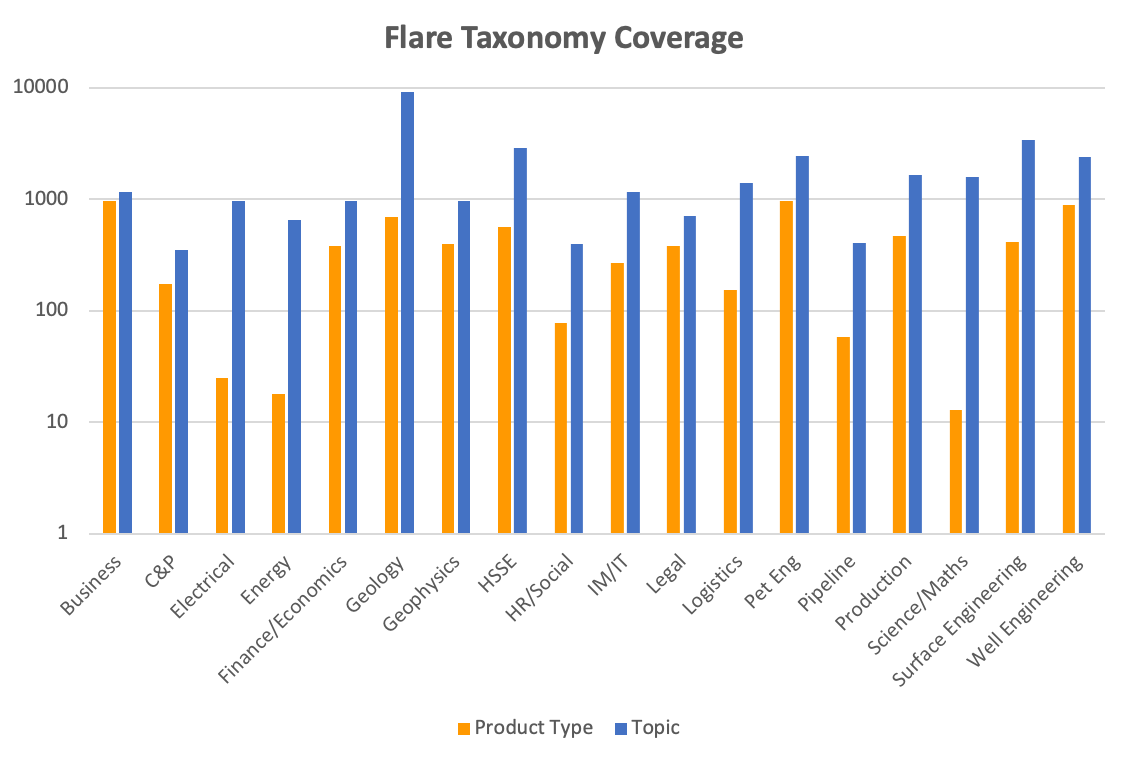Flare provides Industry Taxonomies, a model for master or asset data, tools to use those Taxonomies in Sirus, and an API to integrate the Taxonomies with other systems.
Flare’s Energy Industry Taxonomies
Comprising an integrated set of Taxonomies, there are over 36,000 major terms. The taxonomies are hierarchical and include aliases, synonyms and acronyms and over 450,000 relationships. Additional taxonomy terms are added as part of Flare’s ongoing development of the taxonomy scope.
In 2020, for the Oil and Gas industry a sub-set of approximately 60,000 well log curve names were added.
Developments for 2021 include the addition of an Acronyms module.
The scope of the Taxonomies is illustrated in the graph below,

Master/Reference Data Model
A flexible master/reference data model allows use of the pre-existing master data model, and creation of new master data types, attributes and relationships.
In Sirus or the Sirus API, standard names and valid values can be made instantly available to any application.
What you can do with Taxonomies
Flare has been developing its taxonomies since 2002. The reason this will always be a work-in-progress is that Taxonomies are so much more dynamic than a static list of terms. Used properly, taxonomies can model a business, represent the knowledge in a business, and be used to streamline and improve many information systems. And just as businesses and their terminology change, so do the taxonomies that describe them.
The Flare Taxonomies provide the most robust, comprehensive knowledge map of the E&P business available today. The Taxonomies are comprised of thousands of terms (valid values), relationships, synonyms and aliases to help E&P professionals tag, catalogue, publish and ultimately find their E&P information assets.
The Taxonomies can be licensed as a stand-alone product or integrated with other Sirus modules.
What is a taxonomy?
A taxonomy is a hierarchical list used for classifying things. The Flare Taxonomies are designed to classify all kinds of E&P information but additionally they are associated to one another to create rich semantic relationships between the elements. These business relationships make the Flare Taxonomies much more effective than a simple hierarchy with controlled vocabulary and provide a unique and powerful way to represent knowledge.
Asset classification – the asset taxonomy
Flare’s asset relationship taxonomy supports the business assets typically found in the E&P environment, such as wells, fields, licenses, and basins and is fully configurable to meet individual client requirements. For each asset the company standard name is used as well as aliases including industry names, UWIs and short names. The Catalog user interface allow users to browse and select these assets and utilises the inter-relationships between lists to subset the values displayed; e.g. selecting a country from the country list will limit the fields and wells displayed.
E&P classification – the contextual taxonomy
Flare’s E&P classification methodology is based on the concept of ‘Product Types’, the common information items created by people in the industry. To date over 6,000 product type values have been defined, each one being attributed with a unique name and, in many case, a number of aliases to facilitate searching, as well as defined relationships to other attributes in the taxonomies.
Each entry can contain industry aliases, company specific aliases, foreign aliases, acronyms and examples as well as its relationship to other values.
